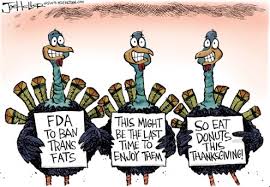THE START OF TRANS-FATS
The rapid emergence of trans-fats from a bit player to a major force from margarines and Crisco in the American diet was the food industry's answer to the results of Ancel Keys' Seven Countries study on saturated fat increasing cholesterol leading to heart disease. Little did they know this was like jumping out of the frying pan and into the fire. Five years after this announcement, Keys discovered that he had made some factual errors in his first study and that saturated fat and cholesterol were not solely responsibly for heart disease. But by then, both modern medicine and the food industry had been so busy instilling this concept into the minds of Americans that the steamroller momentum could not be stopped, even by truth. What is this damage? ref
 It is now known that Trans fats increase type 2 diabetes and heart disease, the very condition they were promoted to help prevent by the food industry. ref Trans Fats lower the "good" HDL cholesterol and raise the "bad" LDL cholesterol. Here is how they do this. Plus, they are a marker for low bone density. To improve bone density, lower heart disease, and reduce type 2 diabetes, do not eat any of the foods listed here, or that have in their label box, the term - partially-hydrogenated oil. Plus the increase in dietary polyunsaturated vegetable oils replacing saturated fats promoted oxidation and inflammation leading to DNA damage and tumor development. ref ref Whether or not a specific vegetable oil increases inflammation may depend upon the ratio of omega 3 to 6 in the oil and also already in the body. Trans-fats displace healthy fats in cell membranes but do not maintain the same membrane fluidity. ref Membrane fluidity is a very important aspect of cell health by controlling what goes into and comes out of cells. ref A report found greater amounts of trans-fats in women with breast cancer. ref ref
It is now known that Trans fats increase type 2 diabetes and heart disease, the very condition they were promoted to help prevent by the food industry. ref Trans Fats lower the "good" HDL cholesterol and raise the "bad" LDL cholesterol. Here is how they do this. Plus, they are a marker for low bone density. To improve bone density, lower heart disease, and reduce type 2 diabetes, do not eat any of the foods listed here, or that have in their label box, the term - partially-hydrogenated oil. Plus the increase in dietary polyunsaturated vegetable oils replacing saturated fats promoted oxidation and inflammation leading to DNA damage and tumor development. ref ref Whether or not a specific vegetable oil increases inflammation may depend upon the ratio of omega 3 to 6 in the oil and also already in the body. Trans-fats displace healthy fats in cell membranes but do not maintain the same membrane fluidity. ref Membrane fluidity is a very important aspect of cell health by controlling what goes into and comes out of cells. ref A report found greater amounts of trans-fats in women with breast cancer. ref ref
ONE VITAL POINT ABOUT TRANS-FATS
In the process of making trans-fats by partial hydrogenation, vitamin K1 changes from it's natural form in green leafy vegetables as phylloquinone into 2,3,dihydophylloquinone. While this new form does some of vitamin K1 functions, it has a number of drawbacks for the complete range of K functions. First, less is absorbed, second, more is rapidly excreted, and third, it fails to impact and correct bone turnover markers. But perhaps the largest failing of dihydrophylloquinone is that it fails to convert into vitamin K2 as MK-4, a vital action for artery health, bone building, and also blood sugar control. ref ref ref To improve bone density, lower heart disease, and reduce type 2 diabetes, do not eat any of these dihydrophylloquinone containing foods listed here.
Once in the body, trans-fats do not rapidly leave the body like other types of fats. Practically all of the phylloquinone in vegetable oils gets changed during hydrogenation into the dihydophylloquinone form. Since vegetable oils represent a major source for vitamin K1, the use of partially hydrogenated oils with mostly dihydrophylloquinone may be a significant aspect in the health of bones, cardiovascular disease, and blood sugar control. ref
WRAP UP
This one dietary change in the form of vitamin K from the rapid increase in foods containing trans-fats beginning in the 1950's could be responsible for a major share of related health conditions. This is also about the time that fast food restaurants became popular. Looking at heart disease, a disease of the 20th century, the rise and fall is almost parallel to the increased use of and the decreased availability lately of foods containing trans fatty acids. ref Could it really be this simple?
For more information, read this article.